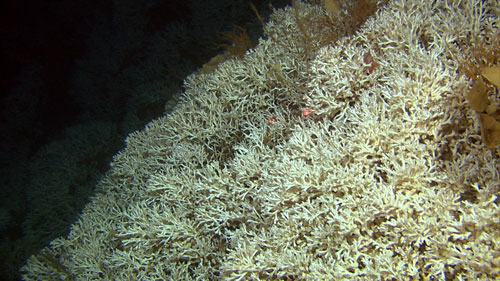Cold-water coral reefs
There are three species of cold-water corals that are known to form reefs in the North Atlantic. The most common is Lophelia pertusa, a stony coral. Lophelia pertusa can form isolated colonies, but under the right environmental conditions these can grow and merge with other colonies to form coral reefs as large as 2.5 km long, as in the case of the Papagrunn reef off southern Iceland. Lophelia reefs develop slowly: the Norwegian coral reefs have been dated to be 3000 to 9000 years old. The biodiversity and structural complexity of the reefs is can increase by the presence of other corals, such as the zigzag coral (Madrepora oculata), which is also considered a reef building coral, and coral trees of the genuses Primnoa and Paragorgia. The third reef building species is Solenosmilia variabilis, which is recorded deeper than the other two species, but has not been confirmed to form reefs in the NovasArc study area. Coral reefs are habitat to a variety of other species, ranging from fish to smaller invertebrates, and harbor higher biodiversity and biomass than surrounding areas.
In locations where currents are strong and the sea bed is hard, sea fans and other non-reefal coral species may provide a habitat for fish, brittle stars and small crustaceans. The most common sea fans constituting hard-bottom coral gardens in the North Atlantic are Paragorgia arborea, Primnoa resedaeformis, Paramuricea placomus and Swiftia spp. Although the biodiversity in these habitats is lower than in coral reefs, they nevertheless sustain many individuals and a large number of host-specific species that are not found in other habitats.
